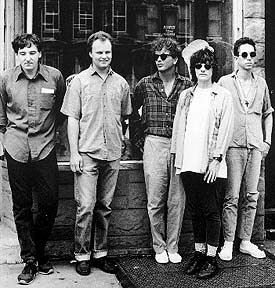
Was there ever a time when the Velvet Underground was unappreciated? Of course. Certainly during the period when they actually existed. I'm sure that, outside New York, Los Angeles and Boston, they were booed as much, if not more, than they were applauded. I personally remember having to lock the door of the dj booth in college when I played "Sister Ray," because the program director wanted to come in and turn it off.
But somewhere along the line, the boos turned into cheers, Lou Reed had a hit single, a million bands claimed the Velvets as an influence, a box set came out, and finally, I think, they even made it into the Rock and Roll Hall of Fame
If you are pining for a band to love who suffers from the same lack of appreciation as the Velvets suffered for so long, may I suggest the Feelies, a band from the same fertile new wave crescent of Northern New Jersey that produced the Bongoes and the Individuals, but with a much more lasting impact.
There is a reason that I led this piece with the Velvet Underground. The Feelies unabashedly borrowed the rhythm guitar style of the Velvet's "What Goes On," (not they were alone - check out many of Brian Eno's tracks on Another Green World) combined it with great Television double leads and Beatle-esque harmonies (not to mention exquisite tastes in covers ) and created a new pop sound that was loved by the bands who got into clubs for free to hear them but not by the record companies or the masses who were meant to buy the four albums they put in their lifetime.
Part of the problem was that the Feelies never seemed that interested in being a band, much less rock stars. They were like a college student who would finish one year of school and then drop out for two or three or five. They put out their first record Crazy Rhythm, on Stiff Records in 1980, but they had already been together since 1976. (I actually met them in 1977 at Terry Ork's loft, when they played percussion for my band Jack Ruby, when we were auditioning for Ork.)
They then broke up, but got back together to put out The Good Earth (my favorite of their records) in 1986. That is probably the record that should have made them stars. It was accessible and warm and full of hummable melodies and intricate pop arrangements. But it did not make them stars.
It only took two years for the Feelies to put out their next album, Only Life, the album which makes clear their debt to the Velvet Underground by actually covering "What Goes On."
Finally, three years later they put out their last album, Time for a Witness, at which point Bill Million, one of the two writer/singer/guitarists, moved to Florida, neglecting to mention to the rest of the band that he was leaving.
As I said, I knew the Feelies slightly back in the late '70's. They were part of the very vibrant post punk scene that coalesced around Maxwell's in New Jersey. But I wasn't a huge fan of Crazy Rhythms, and I lost track of them after that. (Honestly, I lost track of most music for the next eight or ten years.)
When I finally rediscovered them, it was too late to appreciate them in the flesh. However it's still possible to appreciate them on their records, which sound as fresh today as they did when they were released. Some reviewer called them the first alt/indie band, and if you want to talk about powerful rhythms, strong melodies built into the vocal harmonies and the guitar parts, and obscure, hard-to-decipher lyrics - then I would agree. But what I always come back to is the rhythm. I said earlier that they co-opted the Velvet's rhythm from "What Goes On," but really the Velvets smartly stole that rhythm from Bo Diddley and that rhythm is part of the original dna of rock n roll.
The Feelies - The Boy with the Perpetual Nervousness (from Crazy Rhythms)
The Feelies - On the Roof (from The Good Earth)
The Feelies - Higher Ground (from Only Life)
The Feelies - Waiting (from Time for a Witness)
The Velvet Underground - What Goes On (Closet Mix)
The Feelies - What Goes On
